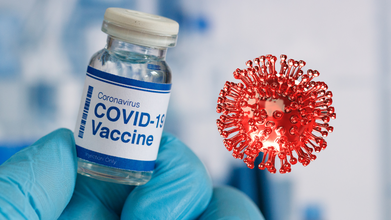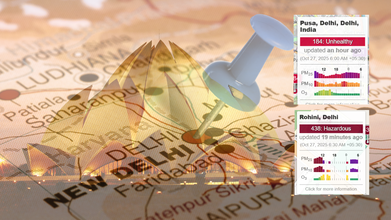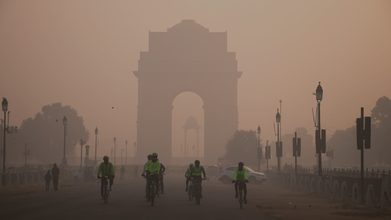- Health Conditions A-Z
- Health & Wellness
- Nutrition
- Fitness
- Health News
- Ayurveda
- Videos
- Medicine A-Z
- Parenting
- Web Stories
UK Recalls Common Blood Pressure Drug Over Packaging Error

Credit: Canva
Patients taking a widely used blood pressure drug are being advised to verify their medication after a batch was recalled due to incorrect dosage information printed on the packaging. According to the Medicines and Healthcare Products Regulatory Agency (MHRA), some packs of lercanidipine, manufactured by Recordati Pharmaceuticals, have been wrongly labelled as containing 10mg tablets, when in fact they contain 20mg tablets.
Over 7000 Packs Are Subject To Recall
More than 7,700 packs already distributed are now subject to the recall, the MHRA has confirmed. Patients who may have the mislabelled medication are being urged to contact their GP, pharmacist, or call NHS 111 for advice. The NHS warns that consuming an excessive dose of lercanidipine can lead to symptoms such as dizziness and drowsiness. The MHRA issued the alert on Thursday after being informed by the Italian pharmaceutical company Recordati that the error was confined to a single batch of lercanidipine, which was initially distributed on April 10. The recalled packs carry the batch number MD4L07 and are marked with an expiry date of January 2028.
Although the front of the affected packs displays the incorrect strength, the correct 20mg dose is printed on the blister strips inside and on the side of some of the boxes. The MHRA advises patients who have been prescribed the 20mg dose to check the blister packaging to ensure they have received the correct medication. However, those prescribed 10mg tablets should seek immediate medical attention if they have this batch.
As a temporary measure, the MHRA suggests that patients who cannot reach a healthcare provider may take half of a 20mg tablet until they receive professional guidance. Dr Alison Cave, the MHRA’s chief safety officer, stated: "Healthcare professionals such as pharmacists are also being asked to stop supplying medicine from the affected batch and to return it to the supplier." She encouraged anyone experiencing suspected side effects to report them through the MHRA’s Yellow Card scheme.
In a statement to the BBC, a spokesperson for Recordati said the company is "working proactively" with the MHRA and will contact all customers who might have received the affected batch. “We are investigating the root cause and continue to work with our partners to isolate the issue and minimise disruption to our patients. Patient safety remains our top priority,” the spokesperson added.
What Do We Know About Lercanidipine?
Lercanidipine is used in the treatment of Angina (heart-related chest pain), Hypertension (high blood pressure), Arrhythmia, hypertensive emergency, subarachnoid haemorrhage and anal fissure. According to the NHS, it is one of the four types of blood pressure medicines sold across the UK. These pills are a calcium channel blocker. That means it regulates blood pressure by relaxing blood vessels and reducing pressure on them, thereby making it easier for the heart to pump more blood throughout the body. In this way, it normalises the blood pressure in patients with high blood pressure.
ALSO READ: RFK Jr.'s Autism Controversial Comments Face Backlash From Parents And Medical Experts
New 'Frankenstein' Covid Variant, Now Called The 'Halloween Monster In The Air' Is Spreading Faster Than Ever, What Makes It So Unique?

Credits: Canva
The new 'Frankenstein' variant of COVID-19 is spreading rapidly. It has been largely ignored, however, this new SARS-CoV-2 variant is causing high levels of sickness absence in nurseries, schools and care facilities and will also increase the number of long COVID patients.
It is the same as the Stratus variant, scientifically known as XFG. It is nicknamed as 'Frankenstein'. Many are also calling this variant the "Halloween Monster in the Air", as it has led to a 37% spike in hospital visits in France.
What Is Happening In The World?
In a very short time, the "Stratus" variant has become the dominant strain. In Germany, it has accounted for 84% of identified SARS-CoV-2 variants at the beginning of October 2025. This variant is also the dominant one in Austria and Switzerland, making up for about 80% of viral load in wastewater.
As per the Robert Koch Institute (RKI), it has also led to rise in acute respiratory illnesses since September. The Frankenstein virus has affected people across ages.
Why Is It Called 'Frankenstein' Variant?
The new variant gets its name 'Frankenstein' due to its genetic fusion of components from different virus types, which makes it an accurate description of a genetic monster. The new 'Frankenstein' Covid variant is a recombinant variant formed from the Omicron lineages LF.7 and LP.8.1.2. The fusion has led to a more resistant and "fitter" strain.
As per the World Health Organization (WHO), the rise in Covid-19 cases are also associated with the same variant. It has been classified by the WHO as a variant under monitoring since June 25, 2025. The evidence while show that the additional public health risk is low worldwide, the mutation makes it more contagious, thus the growing number of cases.
What Makes The New 'Frankenstein' Covid Variant So Unique?
The symptoms, while some of them are quite similar to that of we know from COVID-19, there are some unusual symptoms too, which were often associated with a common cold:
- Sore throat
- Runny nose and congestion
- Dry cough
- Fatigue and muscle pain
- Mild fever
- Loss of appetite
- Shortness of breath
- Chest pain
- High fever in people with lower or weakened immunity system
What Are The Ways You Could Prevent The New 'Frankenstein' Covid Variant?
At present, there is no specific treatment available for the Frankenstein variant. The approach remains similar to that for other COVID-19 strains, focusing on managing symptoms according to how the illness progresses.
Vaccination: Current vaccines are believed to help reduce the risk of severe illness and hospitalization. While their effectiveness may slightly decrease against new variants, they continue to play a crucial role in prevention.
Supportive care: Simple measures such as taking fever-reducing medications, staying well-hydrated, getting enough rest, and using cough suppressants can help ease symptoms.
Preventive practices: Wearing a mask, maintaining proper hand hygiene, avoiding crowded spaces, and keeping a safe distance from others remain key protective steps.
As research on the Frankenstein variant continues, individual protective measures are vital. Because the illness can affect each person differently, it’s important to consult a healthcare professional if symptoms appear.
Delhi Pollution Left People Gasping For Air, But There Are Ways To Stay Safe According To Doctor

Credits: Canva and AQIcn.org
After some days of relief, on Sunday, Delhi again woke up to a thick layer of smog, with pollution levels rising up to 'very poor' category. The centre's early warning system (EWS) forecast that air quality index (AQI) will further deteriorate.
On Sunday, by 7pm, Delhi's AQI was at 299, just below 'very poor' level on the index. Anand Vihar remained at severe levels with the AQI logged at 421 at 11am, by evening, it rose to 428. Wazirpur also slipped into the 'severe' category with an AQI of 408.
As Delhi continues to struggle with smog-filled skies, and thick layer of smoke to breathe through, an earlier video by Dr Divya Prakash, Consultant Physician at Yashoda Hospital on tips to stay safe amid Delhi pollution is making rounds.
What Does The Doctor Say?
Dr Prakash points out that the moment the index goes above 50, the air starts to become unhealthy for us, however, in Delhi, we already see the AQI levels crossing the 400 threshold.
"The main problem is with our lungs due to increasing air pollution. It also indirectly affects our heart and brain. So, how can we save ourselves from this?" He shares that the best way is to use public transports and electric vehicles. He also recommends wearing a mask whenever anyone goes out and urges people to avoid going out at peak hours.
"Eat healthy food, avoid burning wood or construction work around the house and do use your air purifier at home, especially for children and elderly and those who already have lung or other heart problems," he says.
How Poor AQI Impacts Our Lungs?
Air pollution comprises of tiny pollutants and particles called the PM2.5 and PM10, that reach deep into our lungs. These particles, though tiny, are able to inflame the airways and cause breathlessness, wheezing, and repeated coughing. This can further cause healthy adults to suffer from throat irritation, headaches, and fatigue if they are exposed for a long time.
Since children inhale more air per kilogram of body weight than adults, they are at more risk of being harmed by the pollutants. Furthermore, they also have a weaker immunity, which puts them at more risk of such complications.
The World Health Organization (WHO) also notes that not just lungs, but almost every organ in the body can be impacted by air pollution. Thanks to the small size of the pollutants, they can penetrate into the bloodstream via lungs and then circulate throughout the body and could lead to systemic inflammation and carcinogenicity.
What Diseases Could Air Pollution Cause?
Apart from the respiratory diseases like asthma, shortness of breath, COPD, WHO notes that air pollution could is a risk for all-cause mortality as well as diseases like:
- Stroke
- Ischaemic heart disease
- Lung cancer
- Pneumonia
- Cataract
There are evidence that support the link between air pollution exposure and adverse pregnancy outcomes, including low birth weight of the child, small for gestational age, and other cancers, diabetes, and cognitive impairment and neurological disorders in the child.
How Can You Read AQI?
As per the Central Pollution Control Board, here's how the data on AQI can be interpreted
- 0-50 is considered ‘good’
- 51-100 is considered ‘satisfactory’
- 101-200 is considered ‘moderate’
- 201-300 is considered ‘poor’
- 301-400 is considered ‘very poor’
- 401-500 is considered ‘severe’
Delhi’s Air Quality Slips Back to ‘Very Poor’; Toxic Air Could Cause Acute Health Effects, Warns AIIMS Doctor

Credits: Canva
Delhi witnessed a slight improvement in its Air Quality Index (AQI) for a couple of days before it again slipped back to 'very poor' category. On Sunday morning, some areas in fact reached 'severe' category on the AQI.
While pollution spiked during Diwali, on Friday and Saturday, Delhi's AQI was recorded at 275 and 292 respectively, which has placed the air quality category in 'poor'.
However, on Sunday morning, Delhiites woke up to 'very poor' air quality, thanks to the thick layer of smog. The AQI was recorded well above 300 in most areas. Visuals too show low visibility in many areas of the national capital.
What Does The Expert Say About The Air Quality?
On Sunday, as of 7am, Delhi's Anand Vihar area recorded an AQI of 430, which has placed it under the 'severe' category. Wazirpur also recorded an AQI of 403, further placing it under the 'severe' category. Speaking to ANI, former AIIMS Director Dr Randeep Guleria urged people to use preventative measures in order to minimize their exposure to the polluted air. He also warned people of the health implications which could be the result of deteriorating air quality.
"The current high levels of air pollution, indicated by poor AQI, are leading to acute health effects, particularly among individuals with underlying heart or lung conditions, the elderly, and young children. These groups are experiencing increased chest discomfort, breathing difficulty, cough, and worsening of pre-existing conditions like asthma and COPD," Dr Guleria told ANI, on Friday.
"Even healthy individuals are reporting symptoms such as nasal stuffiness, throat pain, chest tightness, and coughing. The inflammation and narrowing of airways caused by pollutants are contributing to these issues. Additionally, the use of crackers, despite permissions for 'green crackers,' has exacerbated air pollution," he added.
What Preventative Measures Should One Use?
The best way to protect yourself is by limiting your outdoor timings, especially during the early morning hours and at the night. Smog is at its lowest during the afternoon. Furthermore, using an N-95 respirator could protect you from the minute pollutant particles in the air.
N-95 is a respiratory protective device designed to achieve a very close facial fit and very efficient filtration of airborne particles, notes the FDA. This is what makes it fit for use during high levels of pollution.
The edges of N-95 are designed to form a seal around the nose and mouth. Some models even have exhalation valves that can make breathing out easier and help reduce the heat build-up.
As per a 2021 study published in the Indian Journal of Radiology and Imaging, the N-95 mask could block "at least 95% of very small test particles".
Read More: Which Mask To Wear For Best Protection?
What Does AQI Mean?
As per the Central Pollution Control Board, here's how the data on AQI can be interpreted
- 0-50 is considered ‘good’
- 51-100 is considered ‘satisfactory’
- 101-200 is considered ‘moderate’
- 201-300 is considered ‘poor’
- 301-400 is considered ‘very poor’
- 401-500 is considered ‘severe’
Delhi AQI as of 7am
Alipur, Delhi (DPCC) - 309.00
Anand Vihar, Delhi (DPCC) - 430.00
Ashok Vihar, Delhi (DPCC) - 369.00
Aya Nagar, Delhi (IMD) - 272.00
Bawana, Delhi (DPCC) - 390.00
Burari Crossing, Delhi (IMD) - 344.00
CRRI Mathura Road, Delhi (IMD) - 330.00
Chandni Chowk, Delhi (IITM) - 376.00
DTU, Delhi (CPCB) - 266.00
Dr. Karni Singh Shooting Range, Delhi (DPCC) - 317.00
Dwarka-Sector 8, Delhi (DPCC) - 301.00
IGI Airport (T3), Delhi (IMD) - 269.00
IHBAS, Dilshad Garden, Delhi (CPCB) - 310.00
ITO, Delhi (CPCB) - 329.00
Jahangirpuri, Delhi (DPCC) - 370.00
Jawaharlal Nehru Stadium, Delhi (DPCC) - 304.00
© 2024 Bennett, Coleman & Company Limited

